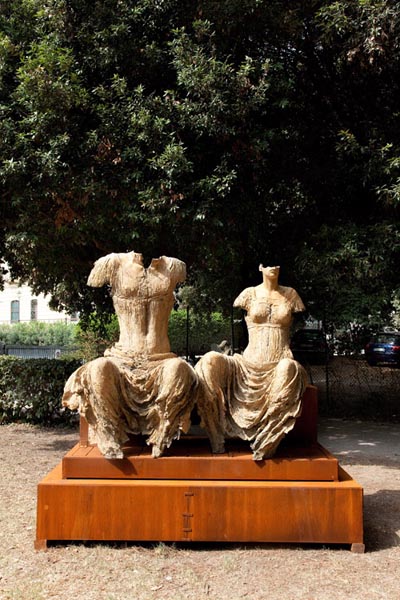ITALIA - UGO RIVA
Sculpture is one of the most archaic forms of artistic expression. When men still did not know anything about the rules of the universe and, on looking upwards, they did not wonder whether other forms of life existed beyond the solar system, nevertheless they had clear ideas about the sense and the meaning of certain words. Heaven was the home of the gods. Earth was the home of living creatures. Living creatures inhabited it in different forms. Ugo Riva’s research began some years ago from this limit suspended between what is immortal and what is not Starting from a solemn, meticulous investigation into the epic world of the heroes established by Mediterranean culture, he revisited the figures of classical antiquity which were among the dearest to the collective imagination, such as the couple Hector and Andromache, by digging deeply into the history of the first inhabitants of Greece and Asia Minor until he finally came to the primigenial idea of a sculpture which is a presence and a ghost at the same time, strength and repetition of legends and tales which are stored in the memory. We are sons of an ancient destiny which developed during many millennia around the pool of the Mare Nostrum. Riva draws on each poem, each elegy, each narrative made credible by the scholars who wrote what had happened since the Assyrian age, when the first artifex created rudimentary stone female divinities which symbolized fertility. Riva’s journey through sculpture led him to read over the main aspects of our existence – life, death, love, peace, war, friendship, family. Without any rhetoric, the artist from Bergamo has accompanied his terracotta or bronze sculptures from a very distant past just outside the walls of Troy up to present time. Today the young girls produced by his skilful hands have absolutely contemporary gracefulness and manners, but maintain the unique refinement and elegance of the first divinities. The imposing work of art which Riva exhibits at OPEN 12, Come imperturbabili dei, is a good representation of the contamination of different ages as well as of the continuity of formal technical matrices which had characterized statuary from Phidias and Praxiteles onwards. The two seated characters, both headless, even though one still has the lower part of her face, have the seraphic calm which is typical of Jupiter and Juno. Their posture is the posture adopted by persons who, from their position, can look, judge, decide. But they are imperturbable Gods. Who are they then? They are two images beyond time, whose strength comes from their beauty and perfection of proportions, from the refined arrangement of the draping, from the haughtiness of their straight backs. Yet, despite the familiarity with the Divine, they remain imperturbable, distant. They transmigrated from a world hanging in the balance between to be and not to be and have come to us with the splendour of their form and with the disquieting secrecy of their names and addresses. To tell us that somewhere they are watching over the human race.
Text by Anna Caterina Bellati
